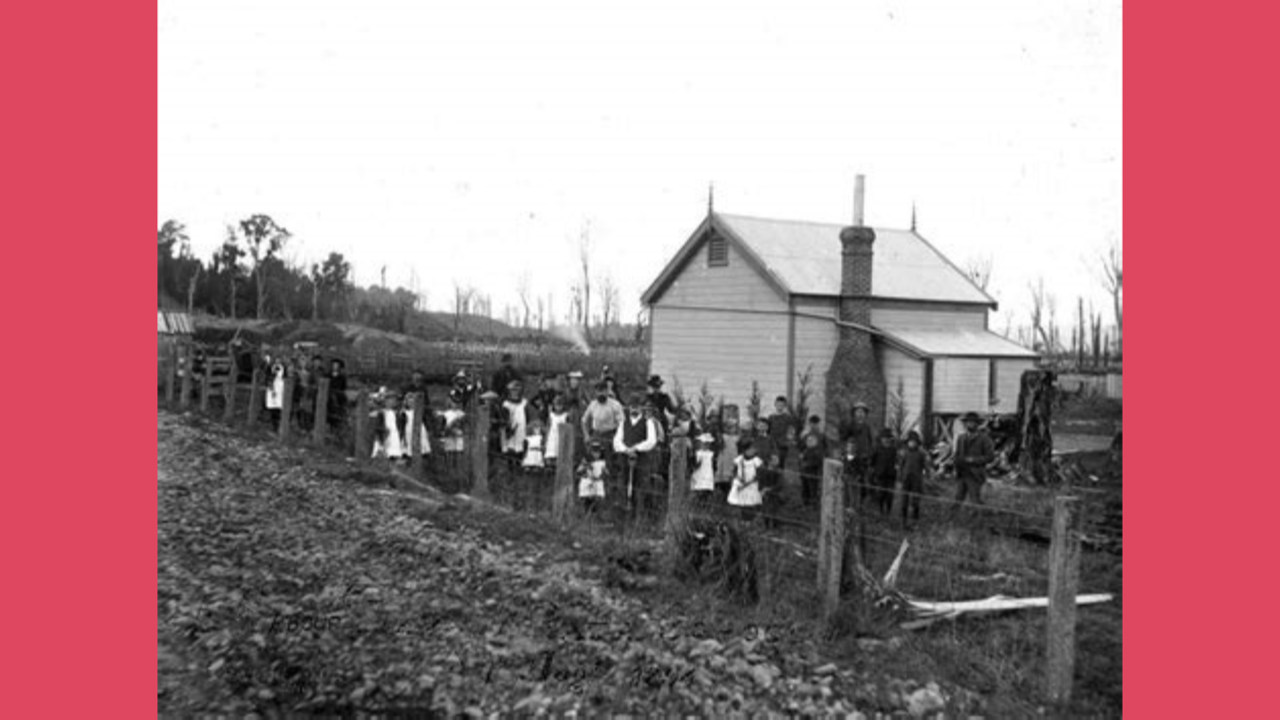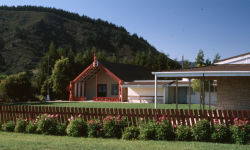
Elinor Thornton (nee Wilson) was a preacher/evangelist in her 20s and early 30s. After marrying Guy Thornton, they served together in several Baptist churches and preached together at evangelistic missions in the United Kingdom.
Elinoru2019s story is unusually significant to the writer (Beulah Wood, Baptist Union President in 2019), because Elinor Thorntonu2019s ministry brought Beulahu2019s grandfather into the family of God.
Elinor was born in 1867 in Dungannon, County Tyrone, Ireland, and arrived in New Zealand on the Carisbrooke Castle in September 1875.
One of six children in a farming family, she loved to learn scripture. She told how when she was 12, she had to stay home to plant potatoes instead of going to a scripture exam u2013 but then, due to a flooded river, the examiner was delayed, and to her delight she was able to participate, coming first! She told how she was u2018strangely movedu2019 at confirmation at 14, but still longed for God.
Her family was cultured and enabled her education. Books were her friends. At 15 years of age, she became a schoolteacher. She rode six miles to and from the school where she taught. On one of these trips in her first year, her horse shied at some paper and galloped into the fern and tea-tree, throwing her from the saddle with her foot caught in the stirrup, dragging her half a mile with her head almost on the ground. When her spur finally tore her shoe, she fell, bruised and lacerated, and could finally get up and make her way home with no serious results.
Elinor moved to teaching at Thames, still feeling restless and incomplete. There, she was touched by a witness from the Salvation Army. Rereading scripture again, she found the Saviour, and her life as a believer restarted when she stood in a public meeting and admitted to trusting Christ. That was the beginning of her speaking in front of others. She started a small weekly meeting in the village, and another in the school after teaching for the day. The first convert was a boy of 18 who later went as a missionary to Africa.
Shortly after, she moved to Remuera school, the u2018pet schoolu2019 of the Auckland Education Board. The headmaster, also a Christian, helped her with the increased responsibilities. She thrived on being in Auckland, the u2018great centre of Christian activityu2019. She taught Bible Class and helped with Christian Endeavour and the Sailorsu2019 Mission for three years. Then she found that u2018a great door and effectualu2019 opened for mission work u2018in the heart of the New Zealand bushu2019 when a Rangitikei land and timber mill owner, Mr Ewen McGregor, invited her to teach school for 40 children, teach Sunday School and take a service every Sunday evening. (The previous minister had left because it was too lonely on the river between Ohingaiti and Mangaweka before the railway.)
She wrote afterwards that u2018Mr and Mrs McGregor were as astonished as I myself when a girl was suggested. But I prayed over the matter for a month or two, then realised that the call was from God.u2019
Elinor left the desirable Remuera position, accepted the job under the Wanganui Education Board, and set out, taking a u2018few odds and ends of furnitureu2019 and her u2018theological library, consisting of Bible, a book of Bible readings by DL Moody, and half a dozen of FB Meyeru2019s shilling booklets.u2019 From Hunterville the journey proceeded by buggy and then u2018a cage running on a wire rope and worked by an engineu2019 to cross the river.
Elinor spent two years there (approximately 1897 u2013 1899) and taught school daily. She studied her Bible, took a Sunday School class and a service each Sunday to which practically the whole village came. During this, men and women were led to Christ. Here is one of her memories.
On the wettest, darkest nights in winter, men, women and children could be seen carrying storm lanterns, coming in every direction down the rough bush tracks, wending their way to the schoolhouse. I sought to preach Christ in my own very simple fashion hardly, however, looking for or expecting any definite or immediate resultsu2014for I knew nothing of evangelistic methodsu2014when one evening, as I was about to close the meeting in the usual way by announcing a hymn and pronouncing the benediction, a member of the congregation rose to his feet and asked if he might say something. He was a Mr Alexander, the clerk and manager (of the timber mill), a man of 35, a splendid character, greatly respected by everyone. I feel still the tense silence, the feeling of expectancy in the meeting as I said we would be glad to hear what he had to say. Then we listened to words something like these: u2018I want to say that until I began to attend these services a few months ago, I never realised that it was for me that Christ had died. Now I know itu2014I want everybody else to know it, and I am so glad to acknowledge myself His follower. By His grace I will follow Him and serve Him as long as I live.u2019
The effect of this open declaration was electric. No sooner had Mr Alexander sat down than there jumped to his feet the young Scotch engineer who worked the engine that ran the cage across the river, Mr Robertsonu2026 saying u2018I am ashamed to say I have never taken my stand as a Christian, and I must do so tonight.u2019
This began what I can only describe as a revival. We experienced continually days of the right hand of the Most Highu2026 The blessing continuedu2014it seemed only a natural thing that it shouldu2014until, in almost every home, there were those who openly identified themselves with Christ.[1]
In another story Elinor tells of an invitation to take a service at a cook-house near which a number of men were building the main trunk railway line. She and elderly Mr McDonald walked several miles and found awaiting them a large number of men. They sang a hymn, u2018God loved the world for sinners lostu2019, Elinor commented on the personal love of Christ in the hymn, and the men listened to the service with rapt attention. On the way back, McDonald told her with tears streaming down his face, u2019I did not know until today, when you spoke about the u2018meu2019 in the hymn that Christ had actually died for meu2026u2019
After two years McGregor encouraged Elinor to give up teaching and devote all her time to evangelism. She commenced work in Mangaweka, which was then the terminus of the main trunk rail line. In her diary she noted 98 people whom she had visited, among whom she held prayer meetings for six weeks. Then she rented the town hall, put up notices of meetings and sermon subjects, distributed handbills and held a weeku2019s mission. All sorts of people attended, and she was amazed at the results. She gave a second series of meetings, continuing for about two years, travelling and preaching.
[1] Thornton, Elinor, Reminiscences, Wright & Jaques Ltd, Auckland, 1943, 23


In 1902 Elinor married Rev. Guy D Thornton whom she had known from seven years previously. They would have two daughters, Lilian Ruth (Platt) and Marjery McGregor (Bradley). The couple joined in itinerant mission work and brief pastorates at Otahuhu Baptist Church (1905) and Sydenham, Christchurch (1906u20138). They began a Baptist mission at Ohakune (1909u201312) working among railway workers, sawmillers and bushmen in the backblocks. Short pastorates followed at Morrinsville (1912u201313) and Whangarei (1914).
Rev Ayson Clifford wrote of Ohakune, which was hemmed in by forest, 1700 feet above sea level, rough and raw and overshadowed by Mt Ruapehu.
An unusual assignment called for an unusual man. Rev. Guy Thornton was such a man. He came from a missionary family. His father was for 30 years principal of Te Aute College. Converted, and baptized in the sea near Gisborne, Guy became an eager evangelistu2026 He brought his wife and family to Ohakune. At first they lived in a cold shanty. There was no church building. A billiard saloon was sometimes the only place where a service could be held. There were few supporting Christians. Congregations consisted largely of non-Christians. The locals called Guy u2018the wowseru2019, but he got them to listen to the Gospel and some of them were won to God.
His health suffered. There were weeks when he was laid up. But he had a remarkable wife in Elinor. She was a person of great saintliness and a fine preacher. She could maintain his work when he was out of action.
When Elinor had health questions in 1912, the Thorntons exchanged pastorates with the Smiths of Morrinsville.[1]
Then Guy left for service during World War 1, probably as a chaplain. Undeterred, Elinor kept preaching. Over some months she accepted successive invitations for service series in Whangarei, Invercargill and Riccarton. Then Guy, ill in hospital in London, cabled her to come to him. On the sea voyage to England Elinoru2019s daughter told some passengers her mother could preach so the captain arranged a service attended by nearly all the women and children in the steerage of the ship. (On the return trip she took services for both men and women, with wonderful response.)
For a while Guy and Elinor served as missioners in England under the YMCA. Elinor conducted the afternoon Bible Readings at each mission and spoke in some of the evening gatherings in places like Sunderland, Leicester, High Wycombe, Edinburgh, York, Manchester, Tiverton, Doncaster and Wales.[2]
At one stage in Woolwich, Elinor and Guy chose not to include an evening sermon from her because it was a large venue and they thought her voice may not carry. But the minister of the church said that people would be disappointed, and urged her to preach, after checking that she could be distinctly heard. She then spoke on several occasions, with more conversions occurring.
Elinor returned to New Zealand before Guy and started services in Lyall Bay, Wellington. After Guy returned in 1922, he became pastor of the South Dunedin Baptist Church. Recurring poor health forced his early retirement in 1926, and he died 1934.
Elinoru2019s love of words continued with five published booklets. The first, u201cSoul Secretsu201d, she wrote before leaving England. Others were u201cA Fragrant Lifeu201d, u201cGuy D Thorntonu201d, u201cPeace: is it Possible?u201d and, when she was in her sixties, u201cReminiscencesu201d. She died in 1946 and is buried in the Hillsborough cemetery, Auckland.
[1] Clifford, Ayson, A Handful of Grain Vol 2, N.Z. Baptist Historical Society, 1982, 74
[2] Thornton, Elinor, Reminiscences, Wright & Jaques Ltd, Auckland, 1943, 23, 29
Sources
Thornton, Elinor, Reminiscences, Wright & Jaques Ltd, Auckland, 1943.
Clifford, Ayson, A Handful of Grain Vol 2, N.Z. Baptist Historical Society, 1982.
Angus MacLeod. u2018Thornton, Guy Dynevoru2019, Dictionary of New Zealand Biography, first published in 1996. Te Ara u2013 the Encyclopedia of New Zealand, https://teara.govt.nz/en/biographies/3t35/thornton-guy-dynevor (accessed 27 November 2020).
Alexander family line
Walter Alexander married in 1907 and settled near Lichfield, Putaruru, where the first two children were Ruth and Matthew. Ruth married John Baldwin who had become a convinced Christian through his friendship with Matthew and under the guidance of Walter Alexander. Matthew and John founded Trinity Lands Trust and Putaruru Brethren Assembly. Ruth and Johnu2019s eldest daughter, Beulah, married Brian Wood of Belmont Baptist in 1967 and they served God in India and Nepal, raising four daughters.


